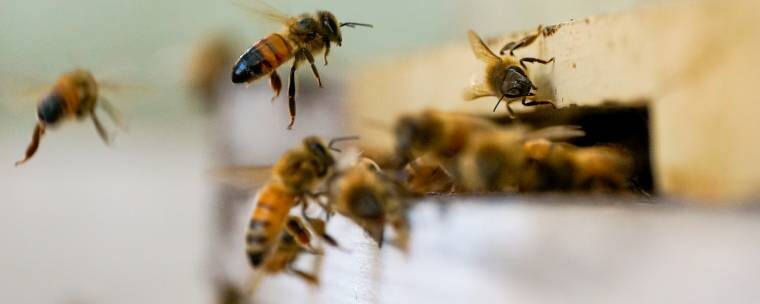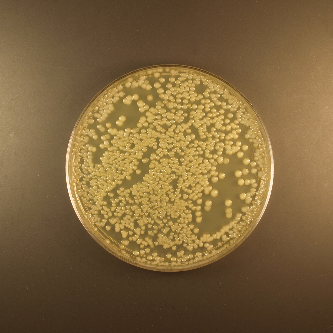
For the targeted hive, the attack can spell disaster — bees may be killed trying to defend the colony's food, while the honey theft leaves the colony at risk of starvation over the winter. Colonies try to prevent these invasions by stationing guard bees outside the hive to monitor the thousands of bees entering and exiting the hive. Guard bees use the smell of other bees' cuticular hydrocarbons (CHCs), compounds that form a waxy, water-resistant layer coating diverse insect species, to identify individuals that try to infiltrate from different colonies. Differences in CHC composition were thought to depend on genetics, but researchers have shown that day-old bees can be integrated into a foreign hive with few cases of rejection.
Cassie Vernier, a former doctoral student at Washington University in St. Louis, has been searching in honeybees' microbiota for answers to the puzzle of the insects' recognition abilities. "The genome of an individual isn't only made up genes found within that organism's genomes, but also the genomes of all the microorganisms that live in that organism," she says.
To test if bees' microbiota can influence CHC composition, Vernier and her Washington University colleagues conducted cross-hive fostering experiments where young bees were raised either in their own colonies or in foreign colonies. The team sequenced gut samples and analyzed CHC extracts in both groups, finding that both a bee's birth hive and the hive in which it grew up influences the insect's gut microbiome, which in turn influenced CHC composition. Of the 14 bacteria that significantly differed in abundance and strain-level variation depending on where a bee had been raised, six were similar among bees that grew up in the same hive, regardless of genetic relatedness.
The researchers also fed various concoctions of microbes to a separate set of newly hatched bees and found that those bees also developed different microbial communities, which in turn led to different CHC profiles. Bees inoculated with a bacterium commonly found in the bee gut accepted other bees inoculated with the same bacterium, but rejected — by biting, stinging, or dragging — bees inoculated with a bacterium typically found on trees, regardless of how genetically related those bees were. "This is the first case where the microbiome is showed to play a role in the basic social biology of the insect, rather than health-related aspects," Vernier says. "In this case, it seems to be driving a basic social behavior that helps the colony survive."
University of Texas at Austin biologist Nancy Moran, who was not involved in Vernier's study and has helped pioneer research on bees' microbiota, says she thinks the new study is "very convincing," adding that it points to yet another important role the microbiome plays in honeybees. Moran says that changes to the microbiome are also likely to be a relevant factor in colony declines, noting that the pesticides that beekeepers use to kill mites in their colonies and weed killers such as glyphosate can obliterate bees' microbial communities and make the insects vulnerable to infection. Historically, "it wasn't recognized that [those bees] don't just drop dead right in front of you, but they become more susceptible to some opportunistic pathogen," she says.
Strikingly, Moran's lab has found that there are many consistencies in the gut microbiomes of honeybees around the world, and that there have been for some 80 million years. "Every worker bee, anywhere in the world, has the same set of bacteria," in terms of microbial taxa, she explains, even though, as Vernier's study shows, strain-level variation within this microbial community is critical for nestmate recognition.
Indiana University Bloomington microbiologist Irene Newton, who was not involved in Vernier's study, has also discovered novel roles for the microbiome in bees' metabolism, behavior, and health. She was astounded by previous research that showed that honeybees can detect when their queen bee has been inseminated — and distinguish between high and low volumes of semen — based on her smell, and may alter their behavior toward her as a result. Newton wanted to learn more about queen biology, and has since found that one bacterium — Bombella apis — is particularly abundant in queen microbiomes, though worker bees and nectar stores also contain trace amounts. She says it's the only microbe she has found that can grow in the "potently antimicrobial" environment of royal jelly, which worker bees feed to the queen.
Newton's lab posted a study on the preprint server bioRxiv last year showing that B. apis produces antifungal metabolites, suggesting that the microbe helps prevent fungal pathogens from taking hold in bees. "The fact that bees bring pollen back to the colony and that we don't see fungi as major parts of any components of the bee microbiome is striking," she says, noting that bees can interact with thousands of flowers a day, yet seem to be resilient against many fungal pathogens that infect plants.
Honeybees represent something of a Goldilocks principle for studies of microbiome functions in insects, Newton adds. "They're the sweet spot of not too complex and not too simple." Other prominent animal models such as Drosophila melanogaster typically only have a couple types of bacteria, and the makeup of the microbiome is much more susceptible to environmental influence because, unlike bees, flies don't have a central colony where they can exchange bacteria with one another.
As for Vernier, studying honeybee microbiomes has changed the way that she looks at bees, she says. "Whenever I see a bee, I immediately think about what's inside of it."




R.C.
*As above, so below.
RC